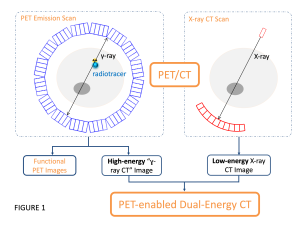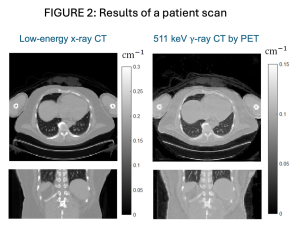 Spectral computed tomography (CT) imaging employs two or more different energies to obtain energy-differential attenuation information of tissue properties. It allows quantitative characterization of tissue composition by material basis decomposition, which cannot be easily achieved by a PET scan. Thus, PET and spectral CT may complement each other to enable a new multiparametric imaging solution for more accurate disease diagnosis and characterization. However, integration of spectral CT with PET would require either a costly scanner hardware upgrade or significant modifications of imaging protocols to allow two X-ray CT scans, which is associated with increased radiation dose and scan cost.
Spectral computed tomography (CT) imaging employs two or more different energies to obtain energy-differential attenuation information of tissue properties. It allows quantitative characterization of tissue composition by material basis decomposition, which cannot be easily achieved by a PET scan. Thus, PET and spectral CT may complement each other to enable a new multiparametric imaging solution for more accurate disease diagnosis and characterization. However, integration of spectral CT with PET would require either a costly scanner hardware upgrade or significant modifications of imaging protocols to allow two X-ray CT scans, which is associated with increased radiation dose and scan cost.
Different from standard spectral CT methods which are based on x-rays, we propose a dual-energy CT imaging methodology based on time-of-flight PET/CT by combining x-ray and γ-ray data, as shown in Figure 1 (Wang, PMB 2020). This new method does not require a change of PET/CT scanner hardware or additional radiation dose except a standard time-of-flight PET/CT scan that is already available on most modern PET/CT scanners. We develop enabling algorithms using the kernel method with or without deep neural networks (Li S et al., IEEE-TIP 2024; Li S & Wang GB, PTRSA 2021; Wang GB, PMB 2020) to reconstruct high-energy “γ-ray CT” attenuation images from the PET/CT scans, which then are combined with the x-ray CT image (low-energy: ≤140 keV) to produce a pair of dual-energy CT images for spectral imaging. The feasibility of this PET-enabled dual-energy CT method for multi-material decomposition has been demonstrated using both real physical phantom scans and human patient scans (Zhu Y et al., EJNMMI, 2025), as also shown in Figure 2.
Funding Support:
This project is supported by NIH under grant no. R01EB036562 from 2025-2029. The early effort was also supported by an NIH Trailblazer R21 Award (R21EB027346) from 2019-2022.
Journal Papers and Conference Presentations:
- Zhu Y, Li S, Xie Z, Leung EK, Bayerlein R, Omidvari N, Cherry SR, Qi J, Badawi RD, Spencer BA, Wang GB.
Feasibility of PET-enabled dual-energy CT imaging: First physical phantom and initial patient study results.
European Journal of Nuclear Medicine and Molecular Imaging, vol 52, 1912–1923, 2025. [Code] - Li S, Zhu Y, Spencer BA, Wang GB.
Single-subject deep-learning image reconstruction with a neural optimization transfer algorithm for PET-enabled dual-energy CT imaging.
IEEE Transactions on Image Processing, 33: 4075 – 4089, 2024. [Code] [Preprint: arXiv:2310.03287. https://doi.org/10.48550/arXiv.2310.03287] - Zhu Y, Spencer BA, Xie Z, Leung EK, Bayerlein R, Omidvari N, Cherry SR, Qi J, Badawi RD, Wang GB.
Super-resolution reconstruction of γ-ray CT images for PET-enabled dual-energy CT imaging.
2023 SPIE Medical Imaging, San Diego, USA, February 19-23, 2023. (oral presentation) - Zhu Y, Li S, Xie Z, Leung EK, Bayerlein R, Omidvari N, Cherry SR, Qi J, Badawi RD, Spencer BA, Wang GB.
PET-enabled dual-energy CT: open-source implementation and real data validation.
2022 IEEE Nuclear Sciences Symposium and Medical Imaging Conference (NSS&MIC), Milan, Italy. Nov 9-12, 2022. (oral presentation) - Li SQ, Wang GB.
Neural MLAA for PET-enabled Dual-Energy CT Imaging.
Proc. SPIE Medical Imaging 2021: Physics of Medical Imaging, 115951G (15 February 2021). (oral presentation)
DOI: https://doi.org/10.1117/12.2582317 - Li SQ, Wang GB.
Modified Kernel MLAA Using Autoencoder for PET-enabled Dual-Energy CT.
Philosophical Transactions of the Royal Society A, 379(2204): 20200204, 2021.
(theme issue on Synergistic Tomographic Image Reconstruction, Part 2)
[Open Access PDF] [Preprint: arXiv:2010.07484. October 2020] - Li SQ, Wang GB.
Kernel MLAA Using Autoencoder for PET-enabled Dual-Energy CT.
16th Virtual International Meeting on Fully 3D Image Reconstruction, Leuven Belgium, July 2021. (oral presentation) - Wang GB.
PET-enabled Dual-Energy CT: Image Reconstruction and A Proof-of-Concept Computer Simulation Study.
Physics in Medicine and Biology, 65(24): 245028, 2020
[Preprint: arXiv:2008.09755. August 2020] - Wang GB.
PET-enabled Dual-energy CT: Exploring a New Way of Spectral Imaging Using Synergistic Reconstruction.
An invited talk at the Synergistic Reconstruction Symposium, Manchester, United Kingdom, November 3-4, 2019. - Wang GB.
PET-enabled dual-energy CT: A proof-of-concept simulation study.
2018 IEEE Nuclear Science Symposium and Medical Imaging Conference Proceedings (NSS&MIC), Sydney, Australia, November 13-17, 2018. (oral presentation)
(DOI:10.1109/NSSMIC.2018.8824351)